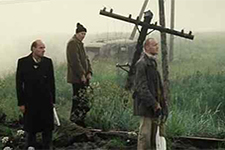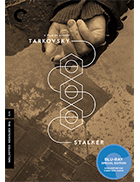Stalker
|  Andrei Tarkovsky’s Stalker is the second of the great Russian director’s 1970s science fiction masterpieces, the first being Solaris (1972). Like that film, it is an emotionally and philosophically intense experience that rewards patience and attention and all but demands repeat viewings. Shot in Tarkovsky’s favored style of long takes (there are less than 150 cuts in the 161-minute film) and slow, methodical camera movements, Stalker is like a companion piece to Solaris, as both films ultimately revolve around the potential horrors of being faced with one’s innermost being; in Solaris, a group of cosmonauts on a space station orbiting a sentient planet are tormented by the appearance of corporeal ghosts from their conflicted pasts, while in Stalker a trio of men venture into a forbidden zone that supposedly contains a room where one’s deepest wishes will come true, which confronts them with the possibility that their most ardent desires may be not be all that honorable. Tarkovsky’s visual emphasis on surfaces and textures makes for a fascinating counterpart to his thematic emphasis on human interiority. Loosely based on the 1972 novel Roadside Picnic (Piknik na obochine) by brothers Arkadiy and Boris Strugatskiy (who are also credited as the film’s screenwriters, although Tarkovksy did a great deal of uncredited work), Stalker takes place in an unnamed country that 20 years earlier was the site of a meteor crash. The area around where the meteor hit has become known as “The Zone,” and entrance has been zealously guarded by government troops ever since it was discovered that a “Room” contained within grants people’s wishes. However, people still manage to sneak in and out of the Zone via “Stalkers,” people who make a living getting people past the guards and machine guns and barbed wire and guiding them through the Zone (in 1970s Soviet visual terminology, the set-up is clearly reflective of the infamous gulags, although in today’s terms the stalkers are much like “coyotes” helping would-be immigrants cross national borders illegally). The title of the film refers to one of these stalkers, played by Aleksandr Kaidanovsky. Against the wishes of his wife (Alisa Freindlikh), who blames him for their adolescent daughter’s physical deformity (she lacks legs and is referred to as a “mutant”) due to his work as a stalker, he agrees to take two men into the Zone: a writer (Anatoly Solonitsyn) and a professor (Nikolai Grinko). Both men have intense reasons for wanting to venture into the Zone and find the Room, reasons that are carefully and slowly revealed as the film progresses. While the characters’ lack of given names and identification by their various professions would seem to suggest that the film is a study in archetypes, each man eventually rejects the assumptions that would go along with being a criminal, an artist, and a scientist, which allows Tarkovsky to emphasize the various conflicts and dichotomies we all have deep within—which is, of course, why having one’s deepest wish granted by the Room is such a dangerous, potentially terrifying prospect. We like to think that our wish would be something beneficial, but the truth is that most people’s deepest desires are the ones they don’t speak aloud because they are, in some sense, unspeakable. As the writer says at one point, “My conscience wants vegetarianism to win over the world. And my subconscious is yearning for a piece of juicy steak. But what do I want?” Like Solaris, Stalker takes place against the backdrop of a sentient environment. In the earlier film, it was the titular planet, which was described as being like a giant mind with supernatural powers. In Stalker, the Zone itself is thought to be somehow alive and aware, as the Stalker is worried about upsetting it by being disrespectful (“The Zone wants to be respected,” he says, “otherwise it will punish”). Tarkovsky uses spatial and temporal distortion once the three men enter the Zone to convey its otherworldliness, although he foreshadows such distortion in an earlier chase sequence, which doesn’t always make visual sense. Tarkovsky’s reasoning is vague in here, which leaves us with the question of whether aspects of the Zone are “bleeding” beyond its understood borders or whether Tarkovsky is simply defying the norms of cinematic space out of pure artistic license. Other visual indicators are more clear-cut, such as the use of sepia-toned cinematography in all the scenes that take place outside the Zone and the use of color inside the Zone—a nod, perhaps, to the visual strategy of The Wizard of Oz (1939) to differentiate “real” from “fantasy”? But, even such obvious strategies are eventually undermined or at least complicated, as Tarkovsky later shoots the Stalker’s daughter in color even though she is outside the Zone, perhaps suggesting that she somehow embodies it. As with all of Tarkovsky’s films, Stalker is rich in visual power, much of which he derives from existing locations in various states of decay and rot. The lush foliage and trees inside the Zone are made both intoxicating and indelibly strange by the constant shroud of mist that eliminates visual depth past a certain distance and its coexistence with decaying, rusting, and crumbling remnants of the human society that once inhabited that area. Stalker is a delight for purveyors of urban decay, as much of the actions unfolds in and around decrepit structures being slowly reclaimed by nature. One of the film’s most unsettling sequences is when the three men must traverse “the Meatgrinder,” a long, dank, dark tunnel beset with all manner of strange noises that eventually opens into a room mysteriously filled with perfectly formed sand dunes. The film’s surreal imagery is always grounded in the textures of the real world, and the film’s visual effectiveness hinges largely on Tarkovsky and cinematographer Alexander Knyazhinsky’s ability to make the mundane imminently strange. As it turned out, Stalker was the last film Tarkovsky made in the Soviet Union, as his follow-up project, The First Day, an intended epic about 18th-century Russia under the reign of Peter the Great, was halted mid-way through production by government censors when they learned that Tarkovsky was deviating significantly from the approved script. Tarkovsky had long been in conflict with the Soviet government; government officials did not approve of his philosophical approach to cinema and focus on metaphysical issues and intense ambiguity, but they tolerated it because he won awards at prestigious film festivals and made the country look good. Stalker, while not cut short by the government like The First Day, nevertheless almost wound up unfinished, as nearly a year’s worth of work had to be thrown out when the lab botched the processing of the new Kodak filmstock used by Tarkovsky and original cinematographer Georgi Rerberg (who shot Tarkovky’s previous film, 1975’s The Mirror), rendering it useless. That interruption almost destroyed the project, but Tarkovsky was able to wrangle additional funds and ended up rethinking much of the film’s second half, which arguably made for an even richer, more evocative work.
Copyright © 2017 James Kendrick Thoughts? E-mail James Kendrick All images copyright © The Criterion Collection | |||||||||||||||||||||||||||||||
Overall Rating: 


 (4)
(4)


